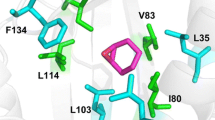Abstract
Despite directed evolution being a practical and efficient method of improving the properties of enzymes, a trade-off between the targeted property and other essential properties often exists which hinders the efficiency of directed evolution. In our previous work, mutant CVH of an esterase from Rhodobacter sphaeroides with high enantioselectivity was obtained by directed evolution, unfortunately its activity cannot catch another mutant YH. To compensate the trade-off of mutant CVH, site-directed saturation mutagenesis was conducted on four residues, three (Asn62, Met121, and Leu145) were hot spots determined from directed evolution, and one (Tyr27) was introduced to make up the large distance between a mutation (Asn62) and the substrate. A new mutant (HMVY) with high enantioselectivity and comparable activity to YH was obtained. According to the kinetic analysis and molecular dynamics simulations, it was understood that the high enantioselectivity and poor activity of mutant CVH was caused by different decrement of efficiency constants to two isomers, (R)-, (S)-methyl mandelate, and the high enantioselectivity and activity of mutant HWVY was caused by improved activity towards the preferred substrate ((S)-methyl mandelate), which provided the interpretation of the trade-off compensation. This work could provide a way to compensate the trade-off of enantioselectivity and activity in the process of enzyme evolution.




Similar content being viewed by others
References
Arnold FH, Volkov AA (1999) Directed evolution of biocatalysts. Curr Opin Chem Biol 3:54–59
Baumann M, Hauer BH, Bornscheuer UT (2000) Rapid screening of hydrolases for the enantioselective conversion of ‘difficult-to-resolve’ substrates. Tetrahedron-Asymmetry 11:4781–4790
Bloom JD (2006) Protein stability promotes evolvability. PNAS 103:5869–5874
Bornscheuer UT (2002) Microbial carboxyl esterases: classification, properties and application in biocatalysis. FEMS Microbiol Rev 26:73–81
Bradford MM (1976) A rapid and sensitive method for the quantitation of microgram quantities of protein utilizing the principle of protein-dye binding. Anal Biochem 72:248–254
Dalby PA (2011) Strategy and success for the directed evolution of enzymes. Curr Opin in Struc Biol 21:473–480
Gu J, Yu H (2012) The role of residue S139 of mandelate racemase: synergistic effect of S139 and E317 on transition state stabililzation. J Biomol Struct Dyn 30:585–593
Hamamatsu N, Nomiya Y, Aita T, Nakajima M, Husimi Y, Shibanaka Y (2006) Directed evolution by accumulating tailored mutations: thermostabilization of lactate oxidase with less trade-off with catalytic activity. Protein Eng Des Sel 19:483–489
Krebsfänger N, Schierholz K, Bornscheuer UT (1998) Enantioselectivity of a recombinant esterase from Pseudomonas fluorescens towards alcohols and carboxylic acids. J Biotechnol 60:105–111
Laskowski RA, MacArthur MW, Moss DS, Thornton JM (1993) PROCHECK: a program to check the stereochemical quality of protein structures. J Appl Crystallogr 26:283–291
Liu J, Tang X, Wang B, Yu H, Min H (2010) Cloning, screening and characterization of ester hydrolases with enantioselectivity in typical bacteria. Process Biochem 45:475–480
Ma J, Wu L, Guo F, Gu J, Tang X, Jiang L, Liu J, Zhou J, Yu H (2012) Enhanced enantioselectivity of a carboxyl esterase from Rhodobacter sphaeroides by directed evolution. Appl Microbiol Biotechnol online first 1–10
Mats H (1998) Insights into the molecular basis for fatty acyl specificities of lipases from Geotrichum candidum and Candida rugosa. Chem Phys Lipids 93:57–65
Parida S, Dordick JS (1993) Tailoring lipase specificity by solvent and substrate chemistries. J Org Chem 58:3238–3244
Raza S, Fransson L, Hult K (2001) Enantioselectivity in Candida antarctica lipase B: a molecular dynamics study. Protein Sci 10:329–338
Reetz MT, Wang L-W, Bocola M (2006) Directed evolution of enantioselective enzymes: iterative cycles of CASTing for probing protein-sequence space. Angew Chem Int Ed 45:1236–1241
Rotticci D, Rotticci-Mulder JC, Denman S, Norin T, Hult K (2001) Improved enantioselectivity of a lipase by rational protein engineering. ChemBioChem 2:766–770
Rui L, Cao L, Chen W, Reardon KF, Wood TK (2005) Protein engineering of epoxide hydrolase from Agrobacterium radiobacter AD1 for enhanced activity and enantioselective production of (R)-1-phenylethane-1,2-diol. Appl Environ Microb 71:3995–4003
Sambrook J, Russell DW (2001) Molecular cloning: a laboratory mannual, 3rd edn. Cold Spring Harbor Laboratory Press, New York
Strafford J, Payongsri P, Hibbert EG, Morris P, Batth SS, Steadman D, Smith MEB, Ward JM, Hailes HC, Dalby PA (2012) Directed evolution to re-adapt a co-evolved network within an enzyme. J Biotechnol 157:237–245
Van Der Spoel D, Lindahl E, Hess B, Groenhof G, Mark AE, Berendsen HJC (2005) GROMACS: fast, flexible, and free. J Comput Chem 26:1701–1718
Wang X, Minasov G, Shoichet BK (2002) Evolution of an antibiotic resistance enzyme constrained by stability and activity trade-offs. J Mol Biol 320:85–95
Acknowledgements
This work was financially supported by the Natural Science Foundation of China (grant no. 21176215), Outstanding Young Scholar of Zhejiang Province (grant no. R4110092) and the Program for Zhejiang Leading Team of S&T Innovation (grant no. 2011R50007). We are grateful for all editors and reviewers for their helpful advice.
Author information
Authors and Affiliations
Corresponding author
Rights and permissions
About this article
Cite this article
Guo, F., Xu, H., Xu, H. et al. Compensation of the enantioselectivity-activity trade-off in the directed evolution of an esterase from Rhodobacter sphaeroides by site-directed saturation mutagenesis. Appl Microbiol Biotechnol 97, 3355–3362 (2013). https://doi.org/10.1007/s00253-012-4516-z
Received:
Revised:
Accepted:
Published:
Issue Date:
DOI: https://doi.org/10.1007/s00253-012-4516-z




